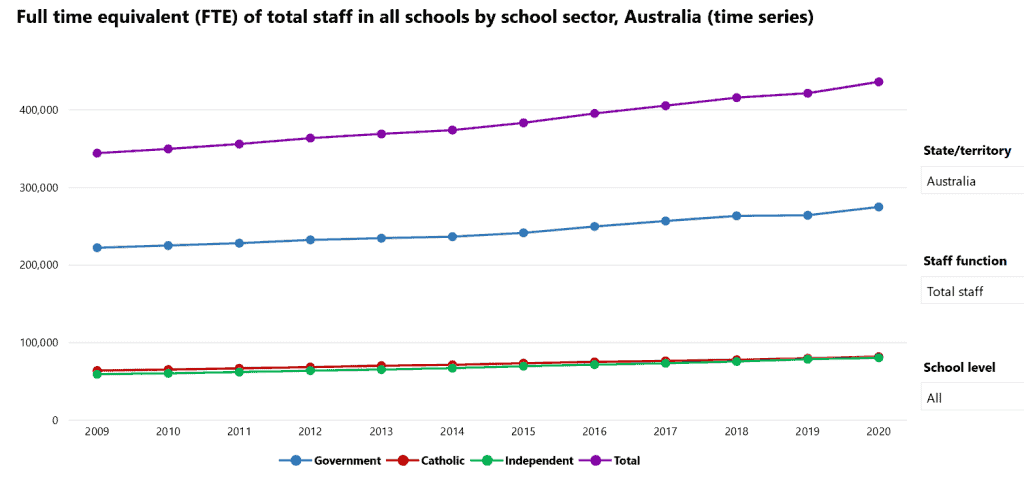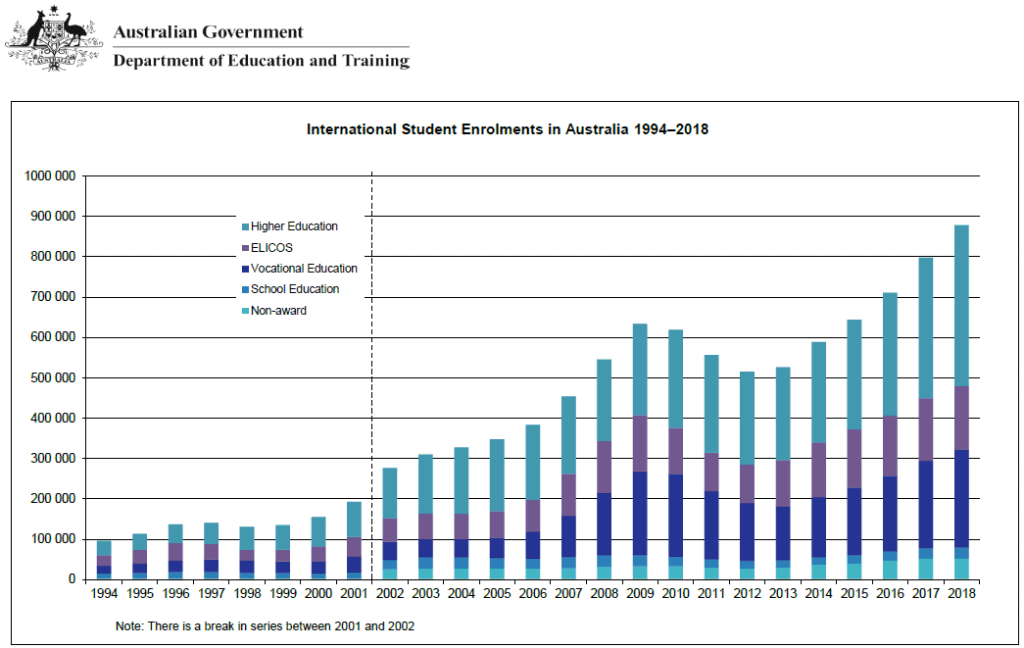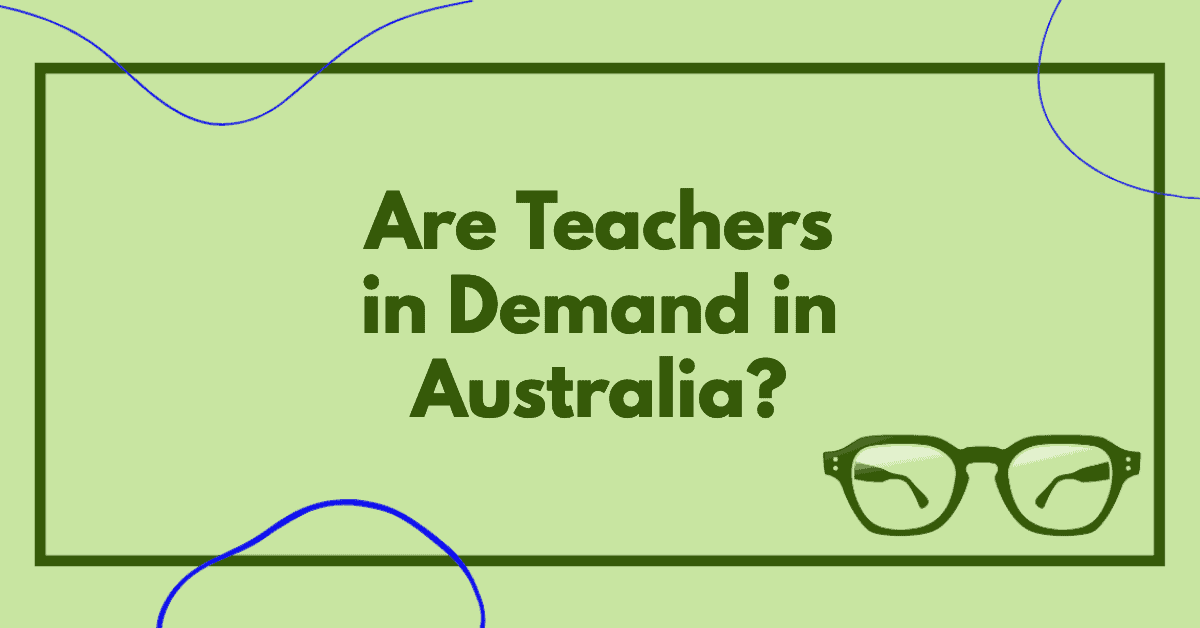The short answer is a resounding yes. Extensive studies have shown that in spite of a growing rate of teachers, Australia cannot accommodate the rise of students. The government is struggling to create new teachers and even when they do, many schools are reporting that they cannot even keep a hold of them.
Despite the reasons why we’re seeing a shortage of supply, the current situation is a golden opportunity for anyone wanting to apply to become a teacher in Australia.
In this article, we will walk through the reasons for teacher shortage, the requirements to become a teacher, the specific areas that need teachers and the benefits you can expect from such a position.
If you are at all interested in becoming a teacher in Australia, look no further for a concise, informative look into the matter.
Let’s begin!
Look back to your own school days and try to recall one of your favorite teachers. How do you feel?
The teachers you remember fondly have, whether or not you realize, made a lasting impression on you. That impact is a massive reason why teachers become teachers.
Teaching is an excellent opportunity to make a difference in a very real and measurable way.
The Australian Curriculum Assessment and Reporting Authority (ACARA) found that the top three reasons of those asked why they became teachers were ‘working with children’ (30.7%), ‘desire to teach’ (22%) and ‘positive impact of role model (11.5%).
Accordingly, the OECD Teaching and Learning International Survey (TALIS) found, in 2018, that “at least 93% of teachers in Australia cite the opportunity to influence children’s development or contribute to society as a major motivation.”
So, if teaching is such a passionate profession, why would there ever be a shortage? As with many things in life, the vision is not always as perfect as materialization.
Teachers in Australia are experiencing a multitude of problems. Many teachers become disillusioned, even in the early years of their teaching career.
A 2007 Inquiry by the Commonwealth Parliamentary Committee showed that up to 25% of new teachers are likely to leave teaching within the first five years of their career.
The Committee’s 2014 study revealed national teaching workforce data that indicated that 5.7% of teachers are leaving the profession in any year.
The reasons that they provided were that teacher’s felt the workload was too heavy and they felt unappreciated. Perhaps you’ve heard that Australia, like many other developed countries, has been struggling with their teachers for some time now.
If you wanted to check, you might take a quick glance at this graph, drawn from the National Schools Statistics Collection (NSSC), which shows that there have been a growing number of teachers every year:

Problem solved, right? Not quite.
Although the number of teachers is steadily rising, which might indicate that the country has a healthy amount of professionals, teacher enrollment is still not keeping up with student enrollment.
Victoria, the fastest-growing state territory in Australia, predicts that, in the next four years, it will need around 1300 additional teachers a year to accommodate some 90,000 students expected to enroll.
Let us not forget that Australia is not some unknown island waiting to be discovered.
It is not just the home-grown students that require high-quality mentorship; there are a vast number of international students who want to study in this beautiful place.
In fact, there is an influx of students coming to the nation, most notably from China, India, Malaysia and Vietnam.

If one of the problems of a teacher supply shortage is the growing number of international students, perhaps one solution is to recruit a higher number of international teachers.
So, you might be looking at the situation and wondering to yourself: “Why would I want to be a teacher in Australia?”
Well, teacher shortages aren’t unique to Australia. Many developed countries have a real problem encouraging people to choose a career in teaching.
However, what is unique to Australia is their unrelenting attack on this problem, showing that they really are a nation that has learned firsthand the impact of teacher shortages and decided that the price is just too high.
Why is Education in Australia Different?
Australia values their quality of education.
Throughout the Covid pandemic, students all over have been disconnected from their learning environments.
Recently, Victoria announced a $250 million investment in tutoring across their schools, with over 4,000 tutors predicted to be utilized in 2021, mainly relief teachers or those who have previously retired.
Most territories of Australia are searching under every rock to find quality teachers.
Projects such as these are becoming more common, with the government placing a real emphasis on not only student welfare but teacher welfare too.
The Department of Education’s current strategic plan (2019-2023) outlines an ambitious goal, centered on student performance and wellbeing. Such a feat will require high-quality teachers, which the government has no issue outsourcing to teachers from other countries.
Although the current travel restrictions make it harder for prospective teachers, and also damage the level of student enrollment, especially at the university level, now could be the perfect time to make your move.
In June of last year, the Australian government proposed to support an additional 39,000 university places by 2023.
They plan to adjust degree cost based on the prospect of “job-ready graduates”, meaning that anyone now choosing a teaching degree will pay 46% less for it.
This will surely attract a great number of people, signalling that they may be successful in closing the gap between teacher and student numbers and that the golden window of opportunity may not be open forever.
What Kind of Teacher Does Australia Need?
In 2019, the Department of Education announced it aimed to “attract high-caliber teachers… by raising the course quality, status and selection criteria of teaching.”
Accordingly, from 2019, high school graduates now need an ATAR of 70 to get into a teaching degree in the Victoria region.
ATAR, or the Australian Tertiary Admission Rank, is a measure of student performance that works by comparing your results against your class.
For example, an ATAR score of 70, which Victorian Universities now requires, actually means you’re in the top 30% percentile of your graduating class; in essence, you beat 70% of the competing scores.
In 2016, a quarter of new students on a teaching degree course actually held an ATAR score of less than 60. These new regulations illustrate that the nation is putting an emphasis on quality, regardless of their teacher shortages.
So, schools won’t be accepting anyone off the street. For teachers working abroad, the requirements are typical of these positions.
How do I Become a Teacher in Australia?
You will, of course, require the relevant qualifications. Your previous, formal study will need to be assessed by the Australian Institute of Teaching and School Leadership (AITS), which will have to be comparable to a minimum of four years of full-time higher education. There are two common pathways you can take:
- You can complete a four-year teaching degree, which will most likely qualify you to become an early childhood or primary teacher
- An undergraduate degree of any subject, such as Science or Math, with a postgraduate teaching degree, will most likely qualify you to become a primary or secondary teacher
If you meet the formal requirements, you will most likely need to complete some kind of refresher course, or sign on to current any training program relevant to the territory you are working in.
Which Teachers Are Especially in Demand in Australia?
ACARA found that among the lower specializations of new teachers were Technology, Arts, Health and P.E. They proposed that ‘the proportion of teacher qualifications exceeded the proportion of student enrollments in Technology, Visual and Performing Arts, Health and PE.’ As to be expected, Science Math and English were the highest, but schools in many areas still require specialists in these subjects.
The New South Wales Department of Education reported, in their workforce projections 2015-2022, that “the supply of primary teachers is very healthy… [and that] even in the case of resignations or retirements doubling, the net supply is more than sufficient”.
They also claimed there was “an adequate supply of secondary teachers, except in the areas of Mathematics, Science with Physics, some subjects in Technological and Applied Studies.”
They predicted a future shortage in other subjects, too, like English, Foreign Languages and History.
However, the Victorian Education Department has said that their margins for secondary level are very tight across all subjects, so this region may be where to look for secondary level roles.
Elsewhere, the Victorian strategic plan states that “for early childhood education, it is important to strike a balance between quickly increasing workforce numbers while maintaining quality,” implying they are currently experiencing significant shortages at the early-childhood level.
There is a clear shortage in teachers for special needs students.
The 2018 TALIS found that “on average in Australia, 29% of teachers work in classes with at least 10% of students with special needs…which is not significantly different from the average.”
However, they also claimed that one in five school principals report their school is “hindered by a shortage of teachers with competence in teaching students with special needs.”
ACARA found that, for recently graduated teachers, Special Education specialization is three times less likely than the Sciences and roughly four times less likely than Math and English.
In reality, the current opportunities differ between territories, but there are definitely opportunities for a large variety of teachers in rural areas.
In fact, the New South Wales Department of Education offers extensive incentives for teachers who choose to locate to schools in isolated, rural areas.
Most notably, “an annual retention benefit of AUD$5000 gross for a maximum of five years in 40 of the most isolated schools.”
Meanwhile, over half of the state schools in the Queensland area are in rural and remote communities, with most permanent teaching vacancies in the Central and North, and Far North regions, with their own incentives. I
It’s important to remember that the population density is very low everywhere across the nation except the cities; most of your opportunities will be in rural schools.
What are the Benefits of Teaching in Australia?
If you’re coming from the UK, USA or Canada, you can expect to possess highly relevant experience, as the curriculum and school life are practically the same.
If you teach primary or secondary level, you can expect a salary of around $70,000 (AUD), and early childhood comes in a little lower at around $63,000 (AUD).
The cost of living in Australia is actually quite high, and you can expect to pay more for many aspects of life. However, rural areas will obviously be cheaper, and you can bag housing allowance or small-city incentives to keep your funds looking healthy.
Don’t let practicalities put you off, though.
In 2015, Australia ranked the second-best country to live in for quality of life.
Australia’s ‘Human Development Index’ (HDI), a metric for an average citizens life expectancy, education, health, standard of life, was measured at 0.935 out of a maximum score of one.
Their measure has been increasing every year.
Many practitioners use the HDI as a rough comparative for happiness, so Australia is clearly doing something very right. The Northern part of the island has a tropical climate, whereas the south corners are temperate.
That translates to sun, sun and more sun. You can expect to live a relaxed lifestyle with lots of outdoor activities in the beautiful landscape.
Conclusion: Teaching in Australia
It’s clear to see that it’s a tumultuous time for education around the world now, with school closures and the transition of online learning, or more unfortunately the absence thereof.
Though Australia is experiencing a continued shortage of teachers, they are actively trying to resolve this.
For now, the demand for teachers is semi-high and not limited to specific areas of study. Many qualified and passionate teachers will be able to find themselves a rewarding position and a sunny, little patch of this exciting country to match.
FAQ
Australia has consistently been ranked highly as one of the best places to live in the world. You can expect to live a relaxed lifestyle with lots of outdoor activities in the beautiful landscape. If you teach primary or secondary level, you can expect a salary of around $70,000 (AUD), and early childhood comes in a little lower at around $63,000 (AUD). Oh and the weather is AMAZING!
You will require the relevant qualifications. Your previous, formal study will need to be assessed by the Australian Institute of Teaching and School Leadership (AITS), which will have to be comparable to a minimum of four years of full-time higher education. There are two common pathways you can take:
1. You can complete a four-year teaching degree, which will most likely qualify you to become an early childhood or primary teacher.
2. An undergraduate degree of any subject, such as Science or Math, with a postgraduate teaching degree, will most likely qualify you to become a primary or secondary teacher.
The answer is a resounding yes! Studies have shown that in spite of a growing rate of teachers, Australia cannot accommodate the rise of students. The government is struggling to create new teachers and even when they do, many schools are reporting that they cannot even keep a hold of them.


So, how does one go about landing a teaching job in Australia if one is from the US and already possesses the degrees and credentials?
Thank you for the detailed information. I have just one question, what is the age limit for an educator to apply for a job, as I meet all your requirements.